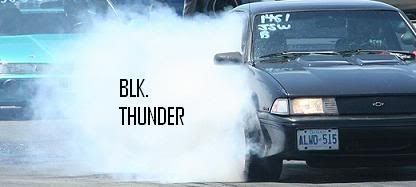On my daily rummaging through the interwebz today, I found a pretty good turbo calculator which plots the air flow and pressure ratio values against compressor maps of a great number of turbos (Garrett, Mitsubishi, Holset, IHI and Borg Warner). It won't be completely accurate, as all engine designs are different, but it's still a good reference that might help those new to turbochargers to read and understand compressor maps better or just to entertain those who do with quick experimenting of different setups.
http://www.squirrelpf.com/turbocalc/index.php
-
"Youth in Asia"...I don't see anything wrong with that.
I've always wanted to put something like that together, but never knew how to index all the maps...
I'm not sure what they did exactly (obviously there are some pretty wild assumptions on the user's part), but the airflow values seem to be quite a bit low. The BSFC is most likely the culprit here I think.
Most importantly...where did they find all those maps!?!?!?
 fortune cookie say: better a delay than a disaster
fortune cookie say: better a delay than a disaster
OHV notec wrote:I've always wanted to put something like that together, but never knew how to index all the maps...
I'm not sure what they did exactly (obviously there are some pretty wild assumptions on the user's part), but the airflow values seem to be quite a bit low. The BSFC is most likely the culprit here I think.
Most importantly...where did they find all those maps!?!?!?
lol.
Yeah, Holset compressor maps are most likely a guestemate as they seem to be one of the most heavily guarded secrets. Most of the other maps seem to be pretty legit though, especially the Garretts considering you can find them just about everywhere.
-
"Youth in Asia"...I don't see anything wrong with that.
Thats a damn fine resource right there. This should become a sticky.
-Chris-
-Sweetness-
-Turbocharged-
Slowly but surely may some day win this race...
As I thought, t04B 60-1 compressor FTW. Next year I get one, and a 4 spd. automatic.
11.92 @ 122.69 MPH Rotrex Blower / Intercooled / Water-Meth / 100% Daily Driver / 381 WHP

I feel like i'm the only one that doesn't truly understand how to use this calculator properly lol. Is there a write up on how to use this calculator the RIGHT way?

1) Enter the max horsepower you intend to achieve
2) Enter displacement of your engine
3) Enter AFR you intend to run (should be around 11-11.5:1 for a street turbocharged engine)
4) Enter Brake Specific Fuel Consumption...they give a link to a pop-up window with "typical" BSFC's
5) Enter Max pressure loss through the intercooler....for the low pressure ratios that most j-body owners run, this should be fairly low (~0.5 or less), but inefficient IC's can see upwards of 2-5 psi drops across the intercooler at high pressures.
6) Enter Max Engine speed
7) Enter RPM at which you plan to make max power
8) Enter spool-up characteristics (Min and Max Boost)...this may involve assumption on your part as both compressor and turbine wheels, housings, and bearing type will have an effect on this. Actually researching others with similar engines and turbochargers would help with this.
---Min Boost: point at which positive pressure is achieved (aka when the turbo starts to "spool")
---Max Boost: point at which turbo stops building pressure (pressure you have the boost controller set to)
9) Enter Volumetric efficiencies for 6-8
10 Enter expected intake temps for 6-8
11) Select Turbocharger from the list and # of those turbos you intend to run
After a graph is displayed, if you click on different maps, the plots will adjust to each map accordingly. If you go back and change fields, you will have to click "Refresh Map" though.
In order to actually read the map though...
There are pressure ratio values on the y-axis which are the absolute pressure divided by the ambiant.... but one could also read it as "boost". 1.0 = 14.7psia (0 psi of boost), 2.0 = 29.4 psia (14.7 psi of boost), etc. The values on the x-axis are the physical lbs/min of airflow traveling into the engine (which is what determines horsepower). The far left slanted line of the map is called the "surge" line. You don't want to build boost pressure too quickly and fall on the left of that line as it causes fluttering and will increase the likely hood of damaging your turbo. Within the map you see oval-ish rings (also referred to as "islands") that correspond to the efficiencies of the turbocharger, with the center oval having the highest efficiency. These are actually 3-D graphs you are looking at, and if it is hard to visuallize what these maps really show, you can think of it similarly as looking down at a cone with rings of different diameters thrown over it. The larger rings are around the outside of your site and lower to the ground (lower efficiency) while the smaller rings are towards the center and higher in relation to the ground (higher efficiency). The last part of the graph is the compressor wheel speed which are curved lines labeled such as 67K, 89k, etc, which refer to 67,000 and 89,000 rpms respectively.
To best match your compressor to your horsepower goals, you want the boost pressure to rise just to the right of the surge line, but to the left of the most efficient region. And as airflow increases (as rpm increases), to maximize the efficiency of your engine, you want the red line they plot on the graph to pass through as much of the most efficient region as possible. That is about as simple as I can explain that. To get a more in depth discussion of compressor maps, you can read
http://www.turbobygarrett.com/turbobygarrett/tech_center/turbo_tech103.html
If none of that answered your questions about the calculator, then I guess you can try the calculator originator's forums
http://www.squirrelpf.com/forums/
-
"Youth in Asia"...I don't see anything wrong with that.
Oh it sure did answer my questions. Thanks whalesac. One thing i'm still trying to grasp, are there any LD9 owners using a 3bar MAP? I'm getting uber weird numbers when attempting to find a combination to run between 3-400 whp. I've done a member search but closest i found was someoe with an SRT4 with a 3bar.

The max power should be input as bhp, right?

Go.Stop (Ron Carvalho) wrote:The max power should be input as bhp, right?
Correct.
-
"Youth in Asia"...I don't see anything wrong with that.
bhp = whp? or are they diferent? I've never really understood that.

WHP = Wheel Horsepower
BHP = Brake/Flywheel Horsepower
I don't know if you didn't understand the acronyms, or that whp is generally 10-15 percent lower than bhp.
If it was the second, than 410 bhp is roughly 350 whp, which obviously makes a difference when choosing appropriate turbo size.

Awesome calculator!
Too bad stuff like this gives me ideas i shouldn't have

_
Now with northstar V8, IRS, 20's n 22's
Quote:
WHP = Wheel Horsepower
BHP = Brake/Flywheel Horsepower
I don't know if you didn't understand the acronyms, or that whp is generally 10-15 percent lower than bhp.
If it was the second, than 410 bhp is roughly 350 whp, which obviously makes a difference when choosing appropriate turbo size.
It was just the acronyms that threw me off. whp makes sence, it's just the bhp that somehow just doesn't sound right to me. Like the wheels bolt on to the braking assembly....logically, it would mean the same thing as whp then wouldn't it?
anywas, thanks for the info.

Yeah, at first bhp confused me too. I was like bhp.. what?
Thanks to this calculator, I now want a T04E Super 50 >.>

Thrice . wrote:Quote:
WHP = Wheel Horsepower
BHP = Brake/Flywheel Horsepower
I don't know if you didn't understand the acronyms, or that whp is generally 10-15 percent lower than bhp.
If it was the second, than 410 bhp is roughly 350 whp, which obviously makes a difference when choosing appropriate turbo size.
It was just the acronyms that threw me off. whp makes sence, it's just the bhp that somehow just doesn't sound right to me. Like the wheels bolt on to the braking assembly....logically, it would mean the same thing as whp then wouldn't it?
anywas, thanks for the info.
Brake Horsepower refers to the way they calculate the horsepower at the crank. They use a hydraulic brake.
-
"Youth in Asia"...I don't see anything wrong with that.









